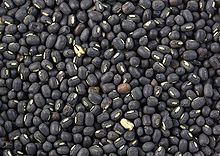Kingdom Plantae Family Fabaceae Tribe Phaseoleae | Order Fabales Subfamily Faboideae Genus Vigna | |
 | ||
Similar Dal, Idli, Dosa, Curry tree, Pigeon pea | ||
Vigna mungo
Vigna mungo, black gram, black lentil, mungo bean (not to be confused with the much smaller true black lentil (Lens culinaris)), black matpe bean, Sanskrit माष / māṣa, is a bean grown in the Indian subcontinent. At one time it was considered to belong to the same species as the mung bean.
Contents
- Vigna mungo
- Vigna mungo black gram
- Description
- Cooking
- Nutrition
- Use in medieval crucible construction
- Names
- References
The product sold as black lentils is usually the whole urad bean, whereas the split bean (the interior being white) is called Ulunthu in Tamil, Minumulu in Telugu,"'uddinabēḷe"' in Kannada, Urad Dal in Hindi, or white lentils.
Black gram originated in India, where it has been in cultivation from ancient times and is one of the most highly prized pulses of India and Pakistan. The coastal Andhra region in Andhra Pradesh is famous for black gram after paddy. The Guntur District ranks first in Andhra Pradesh for the production of black gram. Black gram has also been introduced to other tropical areas mainly by Indian immigrants.
Vigna mungo black gram
Description
It is an erect, suberect or trailing, densely hairy, annual herb. The tap root produces a branched root system with smooth, rounded nodules. The pods are narrow, cylindrical and up to six cm long. The plant grows 30–100 cm with large hairy leaves and 4–6 cm seed pods. While the urad bean was, along with the mung bean, originally placed in Phaseolus, it has since been transferred to Vigna.
Cooking
Vigna mungo is popular in India, largely used to make dal from the whole or split, dehusked seeds. The bean is boiled and eaten whole or, after splitting, made into dal; prepared like this it has an unusual mucilaginous texture. It is also extensively used in South Indian culinary preparations. Urad Dal is one of the key ingredient in making the Idli-Dosa batter, where one part of Urad Dal is mixed with Three or Four parts of Idli Rice to make the batter. Also the dough for Vada or Udid Vada is made from soaked batter and deep fried in cooking oil. The dough is also used in making Papad, notably the South Indian version known as Appalam and Papadum, in which white lentils are usually used.
It is nutritious and is recommended for diabetics, as are other pulses. It is very popular in the Punjabi cuisine, as an ingredient of dal makhani. In Bengal it is made as a preparation called Biulir Dal. In Rajasthan, It is used to prepare dal which is especially consumed with "Bati".
Nutrition
Black gram is very nutritious as it contains high levels of protein (25g/100g), potassium (983 mg/100g), calcium (138 mg/100g), iron (7.57 mg/100g), niacin (1.447 mg/100g), Thiamine (0.273 mg/100g), and riboflavin (0.254 mg/100g). Black gram complements the essential amino acids provided in most cereals and plays an important role in the diets of the people of Nepal and India. Black gram has been shown to be useful in mitigating elevated cholesterol levels.
Use in medieval crucible construction
In medieval times, this bean was used in making crucibles impermeable. The claims of such use are with very weak evidence.
Names
Urad dal is known by various names across South and Southeast Asia. Its name in most languages of India derives from Proto-Dravidian *uẓ-untu-, borrowed into Sanskrit as uḍida:
Its name in selected Indic languages, however, derives from Sanskrit māṣa:
Other names include:
